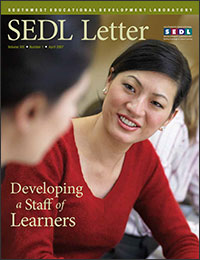Bricoleurs, Behaviors, and Beliefs
“If your job is waking up the dead, GET UP. TODAY IS A WORK DAY.”
—Angeles Arrien, Cultural Anthropologist
We are engaged in an era of cultural change in education. For a successful transformation from preparing students for traditional post K–12 education to preparing students for the year 2020, our most valuable asset in education—our people—need to be motivated, nurtured, and coached. Think of next year’s kindergarten students. They will graduate in the year 2020. What will the world look like? What knowledge and skills will be required to be successful in 2020? Educators need professional development that is job-embedded, that happens in the real world of schools, and that has an eye toward the future.
 To offer the best for students, we want the best staff possible. How do you attract and retain your best staff? What systems, policies, and procedures do you have in place that keep your best staff working for you and your students?
To offer the best for students, we want the best staff possible. How do you attract and retain your best staff? What systems, policies, and procedures do you have in place that keep your best staff working for you and your students?
The best and brightest want to be engaged with authentic challenges. Herzberg and Emery (1987) found the motivating intrinsic factors to retention were the following:
- Variety and challenge
- Elbow room for decision making
- Feedback and learning
- Mutual support and respect
- Wholeness and meaning
Variety, challenge, learning, room to grow—these are qualities that supersede many of the programs we try, such as merit pay, fringe benefits, and bonuses. These are the characteristics that should be infused into our work and professional development.
So how do we provide variety, challenge, learning, and room to grow? My first request: Create ideas and attract and share ideas with others; in other words, we must create thinking communities. Sinetar (1991) uses the term bricoleur to mean “one who tinkers with ideas.” Bricoleurs attract other bricoleurs. Learners attract other learners. Learners are what professional development is all about. Learners create meaning, respond to challenges, and proactively look to the future. They tinker with ideas that will improve teaching and learning.
Ideas are not enough, however. We also want people who are committed to action. If we know and don’t do, then information is useless. We must find out what is working and spread the collective intelligence throughout the school. Communicator Donald H. McGannon said, “Leadership is action, not position.” So what behaviors and actions are you taking to use our great knowledge?
Sometimes our work as professional development specialists, leaders, and team members ignites fires, creates the capacity to act, and models learning. That requires courage, stamina, and a strong belief in the creative development of people.
My second request: You can’t do everything, but you can do something. So do something. Initiate the Butterfly Effect—one small movement of the butterfly's wing can cause major changes in the environment in the long term. Or be a trim tab, which moves large ocean liners. In other words, make it happen for yourself and for others.
We all need to believe in our own power to influence others. One way to assess that ability is through optimism. When professional developers express hope, change and learning are possible. If we don’t have that bright, hopeful, dynamic optimism, we won’t be able to perturb our systems and make them better. One of the leaders’ main responsibilities is keeping hope alive. Here is a short way to remember to keep hope alive (Sommers, 2007):
- H is for honesty and humility. People trust others who are honest. If we are not humble enough to say we don’t know or there might be a better way, we stop looking for answers. As Robert Pascale (1990) said, “Nothing fails like success.”
- O is for openness and options. People who are open to new ideas and feedback continue to learn. A friend of mine, Michael Ayers has said often, "Feedback is the breakfast of champions.” Looking for more options to learn, teach, and lead can move people and organizations to higher levels of performance.
- P is for persistence and patience. We can remain persistent when we have the passion for learning and performance. A former colleague gave me a note with “TTT" written on it. She told me after a meeting no matter how much we want something to happen, “things take time.” I still don’t like to wait, but I know she is right.
- E is for efficacy and enthusiasm. Efficacy is one of the best predictors of teachers’ influence on students’ learning. As Garfield (1986) wrote, it is a high predictor of peak performance. We, in education, can’t do everything—but you can do something. As leaders, people look to us for enthusiasm. Who wants to follow someone who is in the dumps?
So how do we keep hope alive? One way is to focus on what we can do and not spend all our time on what we can’t do. Let’s look at the story of the “Wolf With Two Heads.”
Wilma Mankiller, the first woman chief of the Cherokee Nation, told this story. A young girl was in a chemical dependency treatment center. The experience was not going well. She announced to her counselor that she was leaving the center to go feed the wolves. The counselor followed her to her room as she began packing to leave. The counselor tried to talk her out of leaving but finally said, “I don’t understand the statement about feeding the wolves.”
The girl showed the counselor a necklace she had with a wood carving of a wolf with two heads. She said her grandfather carved it. One head is the wolf of good, and the other was the wolf of evil. The counselor asked, “Which one wins in the struggle?” The young girl looked at the counselor and said, “Which ever one I feed the most.” Which wolf are you feeding the most?
My third request is: Feed the wolf of good and hope. Nobody wants to follow a person who thinks the world is a dismal place. We must be purveyors of hope and optimism if we want to influence others.
Most of us who have spent a fair amount of time in education know that we do not get a lot of positive feedback. As a principal, 90% of my time involves going to meetings and solving conflicts. Both of those activities use a lot of energy. Once in a while a former student will come by to thank me. Sometimes a parent or a former boss will say a kind word. Unfortunately, these are the exceptions. So how do we support our organizations and ourselves?
The answer is easy, and it brings me to my final request: Say thank you. Take a moment to think about who the mentors, friends, and VIPs (very important people) are in your life. Within 24 hours of reading this, I ask that you call, write, or e-mail one of them. Tell him or her what he or she has meant to you. Within 3 days, call, write, or e-mail another person. Within a week, call, write, or e-mail a third person. It will be supportive and gratifying for them to hear your thanks and appreciation. You’ll feel great, too. Honor those who taught you, and honor those whom we teach and to whom we leave our legacy.
Be well. Go forward and make learning happen. AND – Get Up. Today is a Work Day.
References
- Dorsey, D. (2000, November). Positive deviant. Fast Company, 41, 284.
- Garfield, C. (1986). Peak performers. New York: Avon Books.
- Pascale, R. (1990). Managing on the edge. New York: Simon and Schuster.
- Scott, S. (2002). Fierce conversations. New York: Penguin Putnam Inc.
- Sinetar, M. (1991). Developing a 21st century mind. New York: Villard Books.
- Sommers, W. (2007). Our kids deserve your best. Journal of Staff Development, (28)1, p. 7.
- Weisbord, M. (1987). Productive workplaces. San Francisco: Jossey-Bass.
Portions of this article have previously appeared in his columns in the Journal of Staff Development, published by NSDC.
Next Article: Professional Development at the State Level: The Work of the Southeast Comprehensive Center and the Texas Comprehensive Center

